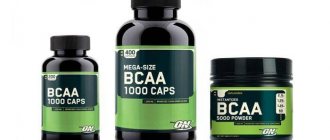Instructions for use of BCAA
We can find a simple indication of the method of using amino acids on any package or can of the corresponding product. Mix one serving (usually 5 g) with 200 ml of water and consume. But here a lot of questions arise: when is it better to take BCAA - before training, or after. Is there a difference in taking BCAA powder and tablets? Should I take amino acids on non-training days? Should I use the same dosage for weight gain and weight loss? Are the dosages different for women and men?
Any instructions can be adjusted to suit your individual conditions, taking into account the mechanism of action of BCAA. These amino acids:
- nourish muscles under load, converting them into energy,
- stimulate protein synthesis through activation of mTOR and other mechanisms,
- act as the basis for protein synthesis,
- suppress catabolism in muscles,
- stimulate insulin secretion, maintaining blood glucose levels,
- activate the release of leptin, reducing appetite and accelerating the breakdown of fats.
BCAA dosage
According to medical research, to replenish amino acids during one workout, an athlete needs approximately 33 mg of leucine per 1 kg of body weight. Thus, a 75 kg athlete would need 2475 mg of leucine, or just under 5 g of BCAA in a standard 2:1:1 ratio. If your weight is less, then the dosage can be proportionally reduced, if more, it can be increased.
Occasionally there is advice to use up to 15-20 g of the supplement at a time, but you need to know that such dosages will not give a positive effect for the muscles, but will only lead to unnecessary costs and harm to health. Firstly, this exceeds the body’s need many times over, which means that excess amino acids will either be excreted without any benefit or stored in fat. Secondly, a sharp and significant increase in the concentration of amino acids also entails an increase in the concentration of their harmful breakdown products, for example, ammonia. The upper limit at which toxic effects (symptoms of poisoning) begin to noticeably affect the dose of leucine is 500 mg/kg, that is, for an athlete weighing 75 kg – 37.5 g.
Correct ratio
I recommend using BCAA products with a 2:1:1 ratio of leucine to isoleucine to valine. In many preparations, the proportion of leucine is much higher, and sometimes it reaches 8:1:1 and even 10:1:1. Many people think that since leucine is so important for muscle growth, BCAA products with a 10:1:1 ratio are five times more effective than products with a 2:1:1 ratio. But before you spend your hard-earned money on these supposedly best BCAA products, listen to what I have to say.
The most important time to take BCAAs is the training window - the period before, during and after a training session. (And, yes, in addition to BCAA, you should also drink a protein-rich shake). This is explained by the fact that the main purpose of adding leucine is to stimulate muscle protein synthesis. This is why many people believe that the higher the proportion, the better.
Some manufacturers make you think that you need to forget about the other BCAAs and start taking only leucine. This would be a big mistake. As evidence, here are the results of a study in which pure leucine was compared with all three BCAAs taken in a 2:1:1 ratio. Scientists at Baylor University gave college students leucine, a 2:1:1 BCAA formulation, or a placebo before and after exercising their leg muscles. The researchers concluded that although leucine increased post-exercise MPS better than placebo, BCAAs stimulated muscle protein synthesis to an even greater extent than leucine and placebo. This is one of the reasons why it is worth sticking to a 2:1:1 ratio (or close to it) when choosing a BCAA supplement.
Another reason to use BCAAs in a 2:1:1 ratio is to increase energy reserves and reduce fatigue. BCAAs are directly used by muscle fibers as a fuel source. This is especially important during intense training, which includes strength training. Numerous studies show that taking BCAAs before exercise increases muscle endurance. More importantly, BCAAs help reduce the accumulation of fatigue during exercise. And this is explained by the role of valine in our body.
During exercise, the brain absorbs tryptophan in large quantities. In brain tissue, tryptophan is converted into 5-hydroxytryptamine (5-HT), better known as serotonin. During exercise, an increase in serotonin levels signals to the brain that the body is tired. This leads to a decrease in muscle strength and endurance. Valine competes with tryptophan at the stage of penetration into the brain. Typically, valine wins.
This means that taking valine in BCAAs before and/or during exercise reduces the amount of tryptophan that enters the brain and is converted into serotonin. This allows the muscles to contract with greater power for a longer time before fatigue sets in. In other words, you'll be able to complete more reps in the gym, recover faster between sets, and retain more strength and endurance in the final stages of your training session. In addition, valine helps you stay more focused and improves brain function on non-workout days.
For these reasons, I recommend sticking to a 2:1:1 ratio (leucine, valine, isoleucine) when choosing a BCAA supplement to take before, during and/or after exercise.
Daily dosage of BCAA
The daily requirement for branched chain amino acids is easily calculated from the need for protein (15-20% of which is optimally BCAA). That is, the minimum is 150-200 mg/kg. But this need is usually covered by amino acids from protein foods. During active physical work or sports, this need (as well as protein consumption standards) turns out to be higher. A diet lacking in complete proteins (for example, vegetarianism) significantly increases the need for BCAA.
Long breaks between meals and bursts of catabolism during training sessions are also important. Therefore, if we are talking about actively building muscle mass, or training for weight loss, then 5-15 g of BCAA taken during the day will help preserve muscles.
How to drink BCAA during training?
If BCAA are consumed in powder form, they can be dissolved in water, add sugar, and you get an excellent drink that can be taken throughout the workout (especially if it lasts more than 1 hour).
The training process actively burns reserves of nutrients (including amino acids) in the muscles, which causes fatigue and destruction of muscle tissue. To compensate for these processes, it is necessary to replenish the reserves of essential amino acids, which BCAA copes with excellently. Protein also helps, but amino acids do not put as much strain on digestion and are absorbed much faster, so they can be taken not only half an hour before exercise, but also during exercise, or immediately after. One serving (5 g) of amino acids before training and one serving after will support muscles well and compensate for the consumption of body resources.
What are BCAA's for?
Let's figure out what BCAAs are and what they are needed for. This trinity of amino acids plays an important role in human physical performance.
Let's study their role and functions using the table:
| Function | Description of impact |
| Enhance protein synthesis | BCAAs enhance the production of insulin, thereby accelerating the flow of amino acids into the blood. |
| Reduce catabolic processes in the body | Due to the entry of leucine into the blood, the production of the stress hormone cortisol, which contributes to the destruction of muscle tissue, is reduced. This is why taking BCAAs during and after training. |
| Accelerates recovery and growth of muscle tissue | BCAA makes up about a third of all amino acids found in our muscles. By replenishing the supply of these amino acids, the athlete stimulates the body to recover faster. |
| Promotes fat burning | Taking BCAA affects the production of leptin, a hormone that regulates metabolism. Leucine promotes its increased secretion. Due to this, the body begins to spend more calories, breaking down fat cells. |
| Can be used by the body as a source of energy | For full performance, the body needs glycogen and amino acids. When muscle glycogen stores are depleted (for example, during a long-term low-carbohydrate diet), the body uses amino acids for energy. If it doesn't have enough free amino acids, it will take them from your muscles. To avoid this, it is recommended to consume BCAAs immediately before training. |
Taking BCAAs is most relevant as a sports supplement during dieting and weight loss. At this time, the body has limited resources for recovery, and BCAAs help cope with stress. In addition, muscle tissue loss is reduced to a minimum.
While gaining muscle mass, most athletes do without this product. If your diet contains enough quality protein from a variety of sources, there is no need for BCAAs. These three amino acids are found in large quantities in chicken, seafood and beef, as well as in other sports nutrition products. Here we talk about nutrition for gaining muscle mass in detail.
How to take BCAA after training?
After training, you need to take BCAA as quickly as possible, especially if you were unable to take them before training. The advantage of amino acid complexes lies in the maximum rate of absorption of leucine, isoleucine and valine, which from the supplement will instantly begin to flow into the muscles, suppressing catabolism and stimulating muscle growth.
If the goal is not to lose weight, then you can combine BCAA with carbohydrates, since leucine and isoleucine activate insulin secretion and improve the absorption of glucose by muscle cells depleted by physical activity.
BCAA – why is it needed in sports?
What benefits does BCAA give if taken during increased physical activity? Let's figure it out.
"Stop!" catabolism
We have already mentioned that after grueling exercise, the level of amino acids in the body is significantly reduced. Because of this, the destruction of protein structures begins, which is a real disaster for any athlete who wants to gain high-quality muscle mass! In order to prevent such disgrace, you must definitely include BCAA in your diet. By doing this, you will definitely take a huge step towards preventing the processes of muscle destruction, and also speed up the recovery period. This effect of this supplement is most clearly visible during the so-called “drying”, when a significantly reduced diet provokes a deficiency of calories and, consequently, amino acids.
BCAA is your reliable and strong shield against aggression and manifestations of catabolism. Protect your muscles from destruction!
Stimulation of insulin production
“Why do we need BCAA?” - you ask. And at least in order to enhance the secretion of insulin and the transport of nutrients to the muscles. It is known that the main anabolic hormone that directly stimulates the production of protein inside the cell is insulin. This hormone also boasts the ability to nullify the functionality of catabolic enzymes. Take a portion of BCAA and fast carbohydrates a few minutes after training, feeling all the delights of the synergetic effect.
Supplementing with BCAA is a huge step towards significant muscle gains.
Starting the fat burning process
What do BCAA amino acids provide if you take this supplement to fight extra pounds? The result will pleasantly surprise you. The thing is that BCAA affect the production of one of the most important hormones that stimulate fat burning - leptin. The speed of your weight loss depends on its quantity. At the same time, the acceleration of metabolism leads to additional burning of subcutaneous fat.
Additional intake of BCAA amino acids guarantees you an advantage in the difficult battle with extra pounds. You are now a clear favorite!
Strengthening the immune system
Any workout is regarded by our body as a huge stress. After all, few of us are used to running a lot or lifting weights in the gym. And a lack of amino acids causes enormous harm to the immune system. And this, in turn, significantly reduces the protective capabilities of all systems, which can provoke the development of a variety of diseases. Therefore, taking BCAA will provide you not only with all of the above benefits, but will also significantly strengthen your immune system.
Why do you need special drugs to support immunity if there is the BCAA amino acid complex, which can easily replace all expensive pharmacy pills.
Influx of energy right during exercise
Taking additional BCAA supplements not only restores the body and prevents muscle breakdown, but also serves as a method of providing an energy boost. Leucine is the most important supplier of energy among all representatives of the amino acid group. Its complete oxidation in muscle fibers releases a huge amount of energy, which is twice as high as glucose!
Do you have a goal to skyrocket your performance, endurance and strength, but don’t know how to do it? Then just include BCAA's in your diet. The results will be amazing!
If you want to purchase a complex that contains not only BCAAs, but also other amino acids, then we advise you to buy an amino acid complex. Let us immediately make a reservation that complex amino acids most often have a much lower concentration of essential amino acids, which is why the price of BCAs with their high dosages is almost equal to the complexes.
How to drink BCAA powder?
The powder form is the most traditional, its price is usually minimal. The main advantage is the ability to dissolve amino acids in water and take them during training, as well as freely mix them with any other supplements - creatine, carnitine, citrulline and even protein.
To drink BCAA powder, you will need a shaker: these amino acids do not dissolve very well and a significant part of them can float on the surface, resisting attempts to stir them with a spoon. A sports shaker will cope with this task with a bang. However, today micronized forms with improved solubility are on sale - they are easier to take.
Another nuance is that natural BCAA without flavoring additives are very bitter, so when purchasing amino acids in powder, it is better to choose a taste that suits you.
How to calculate your individual BCAA dose
The issue of the amount of branched chain amino acids consumed is still controversial in the bodybuilding community. Some athletes believe that large dosages will only be beneficial, while others, on the contrary, believe that it is necessary to stick to minimal portions. The fact is that athletes receive a certain amount of leucine, valine, isoleucine with food. Naturally, it is not possible to calculate exact figures, therefore there are no clear guidelines for additional intake of the BCAA complex.
If you are new to bodybuilding, follow our recommendations. In previous chapters, we presented the body's daily requirement for BCAA (leucine - 8-15 g, valine - 2-6 g, isoleucine - 3-6 g). These figures are calculated for athletes involved in strength training. Each manufacturer indicates on the packaging the composition of one capsule or measuring spoon of powder. Compare the data on the jar of the complex with the daily requirement and calculate the approximate amount of supplement intake. Divide the resulting amount into 3 servings (before training, during, after). Choose your complex:
How to take BCAA tablets?
The tablet form of BCAA is very convenient, if you can’t bother with a shaker, you need to take amino acids in an uncomfortable environment - at work, during a trip, on a plane, etc. In addition to ease of administration, there are other advantages - there is no need to choose a flavor, and there are no flavorings or other additional ingredients. The only inconvenience will be that the tablets must be washed down with water, but a small bottle will solve this problem.
It is also necessary to pay attention to the fact that the dosage of amino acids in tablets may be less than in a serving of powdered BCAA, so you may have to take more than one tablet.
How to choose BCAA
There are dozens and even hundreds of companies on the sports nutrition market, each of which produces its own BCAAs. In order not to get confused in this variety, we will tell you what you should pay attention to when purchasing essential branched-chain amino acids.
Release form
There are four forms of essential amino acids BCAA: powder, tablets, capsules, and liquid. Each form has its own advantages and disadvantages. Let's look at them in more detail:
- Powder . The most affordable type. In addition, the advantages include fairly rapid digestibility (about 15 minutes). The disadvantages of the additive are poor solubility in water and an unpleasant bitter taste. There are powders with flavorings. They cost a little more, but are much more pleasant to use than “pure” BCAAs. Note that amino acids with sweeteners can harm athletes who want to lose weight. Therefore, such supplements should not be taken immediately after training;
- Pills . They cost more than powder and are absorbed by the body for quite a long time (35-40 minutes). In addition, some manufacturers include a very small amount of BCAA in one serving. Because of this, you have to swallow a lot of dry tablets at one time. The main advantage: no need to mix in liquid;
- Capsules . They cost a little more than tablets. In terms of ease of use, capsules are superior to the two previous forms, as they have a slippery gelatin shell and are smaller in size. But you will have to swallow a lot of them. For some manufacturers, the number of capsules per serving can be up to 10-12 pieces. The main advantage is the high speed of absorption (on average 15-20 minutes);
- Liquid form . The main disadvantage: overpriced and fast consumption. As a rule, such products contain fragrances and flavoring additives, which may not be very useful for athletes who are losing weight. Advantages of the liquid form: quickly absorbed (10-15 minutes), does not require dilution, and is easy to swallow.
For athletes on a budget, we recommend the powder form of BCAA, as this supplement has the best price-quality ratio. Yes, you will have to work a little with dilution in liquid. But in return you will receive a “pure” easily digestible product at a low price.
The ratio of amino acids in the composition
On all packages with BCAA you can find numbers that are incomprehensible at first glance: 2:1:1, 4:1:1, 8:1:1 and even 12:1:1. What do these numerical ratios mean? Let's figure it out.
So, we already know that the supplement in question consists of three essential amino acids: leucine, valine, isoleucine. The numbers presented above precisely determine the quantitative ratio of these amino acids in the supplement. For example, let’s take the indicator “2:1:1”. It means that in one serving, for 2 parts leucine, there is one part valine and isoleucine. But why is there always more leucine at any ratio? Because this amino acid is the most important for muscle recovery and growth.
So, we understand what the numbers on the packages mean. Now you need to decide which one is better. The 2:1:1 amino acid ratio is the most affordable, but far from the most effective for muscle growth.
BCAA 8:1:1 is considered to be the closest to the composition of human muscles. Therefore, this supplement is best suited for bodybuilders.
By the way, the higher leucine content (12:1:1) is considered by many experts to be a cunning marketing ploy. According to professional athletes and coaches, large amounts of leucine will most likely not be absorbed by the body. Therefore, we do not recommend spending money on amino acids with this ratio.
Rating of popular BCAA
Below is a list of effective BCAA complexes. By choosing any of the proposed supplements, you are guaranteed to get a positive result.
- Ultimate Nutrition BCAA Powder 12000 (RUR 1,000-1,100);
- Scivation Xtend BCAA (RUR 2100-2600);
- Dymatize BCAA Complex 5050 (RUR 1,700-RUR 1,800);
- Weider Maximum BCAA Sintho (RUR 1900-2000);
- Optimum Nutrition Mega-Size BCAA (RUR 1300-1500);
- Sun Pro Reloaded BCAA (RUR 1,700-RUR 1,800);
- USPLabs Modern BCAA+ (RUR 1,700-RUR 1,900);
- Olimp BCAA Xplode (RUR 1600-1700);
- Maxler Amino BCAA 4200 (RUR 1,400-1,500);
- BioTech BCAA 6000 (RUR 900-1100).
Prices may vary depending on the quantity of product in the package. All manufacturers presented in the rating have extensive experience and a good reputation in the sports nutrition market around the world. Feel free to purchase one of the listed BCAA options.
How to take BCAA capsules?
Capsules are one of the most convenient forms. To drink them, you just need to swallow them, you don’t even have to wash them down with water. Other advantages include no taste, minimal amount of foreign ingredients. The disadvantages include the fact that the capsules cannot be dissolved in water and drunk during training. For the same reason, the absorption time of capsules will be slightly longer. And the dosage may also require taking several capsules. Otherwise, it is a very convenient and effective form of BCAA.
In essence, different forms of amino acid release only affect the convenience of taking them - inside there are still the same leucine, isoleucine and valine, which will work inside the muscles with the same efficiency.











